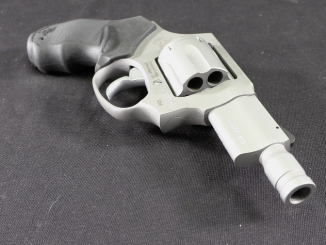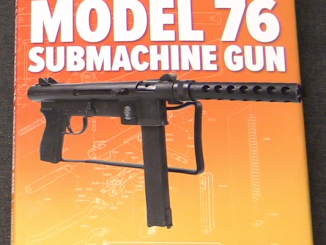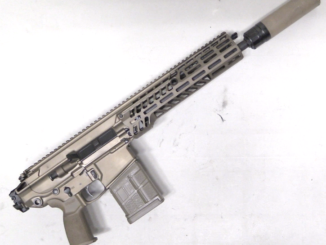During the development of the 1860 Army revolver, Colt did consider mechanical options other than simply scaling up the 1851 Navy pattern. One of these, as evidenced by this Colt prototype, was an enlarged version of the 1855 Pocket, aka Root, revolver. That 1855 design used a solid frame and had been the basis for Colt’s revolving rifles and shotguns, and so it would be natural to consider it for use in a .44-caliber Army revolver. How extensive the experimentation was is not known, and I believe this is the only known surviving prototype of a Dragoon-size 1855 pistol. It survives in excellent shape, and is a really neat glimpse at what might have been…
Related Articles

Commentary
How Companies Bend US Import Laws (An Example)
Part of the 1968 Gun Control Act in the US put restrictions on importation of small handguns. These rules intended to protect US manufacturers and prevent people from having access to particularly inexpensive and concealable […]

Book review
Book Review – Smith & Wesson Model 76 SMG by Frank Iannamico
Available from Amazon or direct from the publisher. Frank Iannamico’s new book on the Smith & Wesson Model 76 submachine gun is in fact a book about much more than just the Model 76. It begins […]

Semiauto Rifles
SIG M5 Spear Deep Dive: Is This a Good US Army Rifle?
The NGSW (Next Generation Squad Weapon) program began in 2017 to find a replacement for the M4, M249, and 5.56mm cartridge. It came to a conclusion in April 2022 with the formula acceptance of the […]

Hmm… it appears that this revolver could be easier to maintain, if corrective procedure involves removing the hammer for reworking…
I am biased because I am a poorer member of the Root family ( there are a lot of us as we came over in the 1630s), but I love this idea! Add a detachable stock and it would be a viable weapon for short, sharp engagements at 100 yards or less. Not a replacement for the 1860 Army we all know and love, as it would be unnecessarily heavy and awkward for most handgun users, but a good supplement for cavalry and similar forces.
I suspect the reason it wasn’t “proceeded with” may be that it was- but by a different gunmaker.
I recently got curious about the resemblance between the Colt Root revolver design and that of the early Civil War Joslyn revolver;
http://www.antiquearmsinc.com/joslyn-revolver-antique.htm
In fact, they are virtually identical.
About 3000 revolvers of this type were made in 1861-62 by the Joslyn firm in Stonington, VT, before they shifted all production facilities to making their single-shot breechloading carbine in .52 Spencer rimfire. Before that, they had made a combustible-cartridge breechloader very similar in design to the British Westly Richards “Monkey Tail”.
Note that during the war, Starr also made both revolvers and breechloading cavalry carbines. So it wasn’t exactly an unknown “business model”.
The patent date on top of the Joslyn revolver’s barrel reads “May 4, 1858”, identical to the patent date on the last model of Colt-made Root revolvers.
I strongly suspect that Colt simply licensed the Root design to Joslyn, and thus a five-shot .44 version of the Root “Dragoon” ended up being sold under the Joslyn trademark.
cheers
eon
“Joslyn revolver”
Notice that, besides sidehammer it has octagonal barrel.
I think that it might done to appeal to users accustomed to older weapons – flint-to-percussion conversion rifles (which also have asymmetrically placed hammer).
Octagon barrel now are considering as looking antiquated, however I am not sure whatever in 1860s they were considered as looking antiquated or not.
There were several reasons for octagonal barrels back then, some subjective, others very practical.
Highly-accurate target rifles of the time had octagonal barrels with no taper, much like round target “bull” barrels of today. So at the time, the octagonal barrel was associated with accuracy.
Note the octagon barrels on the postwar Sharps and Remington “Business Rifles” used by the buffalo hunters out West. Not to mention the octagon barrels on Winchester lever-action rifles, as opposed to carbines, right up through the 1886 model.
Also, the octagonal cross-section added a bit of weight up front, which on a rifle made it steadier when fired from a rest, less likely to be nudged off target by factors like the shooter’s breathing, or even his heartbeat. with the relatively low velocities of rifles of the day and their consequent high trajectories at long range, this was at least as critical as it is with modern long-range shooting.
In a handgun, the forward weight of the octagon barrel helped counteract the tendency of most people to “push” the revolver at the target, throwing the muzzle up and generating a miss. This was especially common in combat, and still is today. Also in target shooting; note the number of target pistols with barrel weights.
Experts on dueling with pistols were aware of this, notably gunmakers like Joe Manton. He not only built his duelers with octagonal barrels, he advised his clients to aim for their opponent’s thigh.
Finally, with the metals of the day (which weren’t all that strong by our modern standards), the octagonal barrel added strength by sheer mass. This helped avoid a problem with the barrel splitting or even bursting at chamber in a single-shot arm, or at the the forcing cone in a revolver.
The Confederate Spiller & Burr revolver, basically a combination of a Remington frame and Colt lockwork, had both an octagonal barrel and the frame carried forward over the first inch of the barrel to completely enclose the forcing cone/leade’ section;
https://www.traditionsfirearms.com/data/catalog/products/images/128/original/FR18625.jpg
All of this was intended to provide increased protection against the barrel splitting or bursting at that point.
The reason was that unlike the modern Traditions reproduction made of steel from one end to the other, the original had a brass frame and a cast-iron barrel.
So it needed all the help it could get.
cheers
eon
“Finally, with the metals of the day (which weren’t all that strong by our modern standards), the octagonal barrel added strength by sheer mass. This helped avoid a problem with the barrel splitting or even bursting at chamber in a single-shot arm, or at the the forcing cone in a revolver.”
But then why not use thicker but round barrel? I would say that edges are places where stress can collect and thus having more edges is better and so round shape is best (which has infinity of edges). For example de Havilland Comet jetliner
https://en.wikipedia.org/wiki/De_Havilland_Comet
prototype has square windows, which were later changed to oval.
I’d actually suspect the reason it wasn’t produced was owing more to its size. Colt was already producing the dragoon series, but those, like the Walker, were large “horse pistols” meant to be worn on the saddle, rather than on a belt holster. This gun was the same size as the dragoons, and wouldn’t have been most people’s first choice as a carry gun. The 1851 navy had become popular because it was light enough and handy enough to carry on the belt, but it was only a .36 caliber. The goal for a new .44 was to combine the portability of the navy, with the power of the larger .44 caliber load, and I think the size of this gun — since it would just been another dragoon size piece, and they were already producing dragoons — was the deciding factor. So they used the 1951 navy frame and just enlarged the front of the cylinder to get the best of both worlds.
eon,
The Joslyn patent of May 4, 1858 is US20160
The Colt patent of May 4, 1858 is US20144
Although somewhat externally similar, their internal mechanisms are completely different. One of the key things to note on the so called “Root Revolver” is the lack of cylinder-stop cuts.
If Colt wanted to press it, they might have been able to get Joslyn on infringement based on patent US18678 of November 24, 1857 among others, and they may have done just that. I don’t have any reference that specifically mentions them going after Joslyn.
Coincidence strikes again!
Did you know that two other inventors went to the patent office with their own designs for telephones the same day as Alexander Graham Bell did?
He just got there a half-hour earlier.
NB; One of the other two was Thomas Edison.
cheers
eon
I bought a Remington 1858 New Model replica back in the 1990’s rather than a Colt because of the stronger top strap frame. If a replica of this had been available for the same price back then or if it was offered for a reasonable price today I’d get one.
“I’d get one.”
What you think about Beaumont-Adams revolver?
https://en.wikipedia.org/wiki/Beaumont–Adams_revolver
if I am not mistaken it is double-action in modern sense percussion revolver, that is only one trigger, not false trigger, which is de facto cocking lever.
And if you want smaller caliber than original (.442″) there was also license built version in .36″ caliber, see photo:
https://www.collegehillarsenal.com/shop/product.php?productid=498
And there was also .31″ version, see photo:
https://www.the-saleroom.com/en-us/auction-catalogues/cowan/catalogue-id-cowans10006/lot-911fd97e-e567-4d48-afcf-a5e900eb7f01
Adams also had cocking lever/false trigger, it is just that mechanism was internal unlike Starr/Tranter where part of it was external.
First “modern” SA/DA was Lefaucheux “Triple Action” model.
I though about user point-of-view: each trigger squeeze = fire or you can cock hammer to lighter pull. Does Adams-Beaumont work like this or am I mistaken?
That’s how the Starr double-action works, but the Beaumont-Adams works basically like the Smith & Wesson or Webley DA.
The Kerr DA works a lot like the later Colt double-action. The Colt system, BTW was designed by William Mason in 1875-76. He had previously designed a similar system for Remington while working there in 1865-66, which Remington used as an option on their first generation of postwar revolvers in both percussion and metallic-cartridge types.
Mason also designed a swing-out cylinder system at Remington, that was later the basis for the Colt system he co-developed with Carl Ehbets in 1881, which was introduced on the Colt New Model Army and Navy .38 revolvers in 1892.
cheers
eon
Also, the Beaumont-Adams always came with a spare cylinder, and could quickly be reloaded by simply pushing the cylinder-pin release button through against its spring, pulling the cylinder pin out halfway, dropping the empty cylinder, putting a loaded one in, and shoving the base pin back.
It’s the same basic procedure seen used by the Preacher (Clint Eastwood) with as Remington metallic-cartridge conversion in Pale Rider (1985), and yes, they really did it like that back then.
The Adams and Remington revolvers could be reloaded in this way nearly as quickly as a modern self-loading pistol can be reloaded with a box magazine. This gave them a fearsome firepower advantage in their own time, and is still pretty respectable today.
It’s worth noting that Confederate guerrilla leader John Singleton Mosby had his men carry at least two and preferably four revolvers in their saddle holsters to ensure maximum firepower. His personal choice was a quartet of .44 caliber Adams double-actions- with two spare capped cylinders per gun in a handy pouch.
Total- 48 rounds.
Very little “waiting”.
cheers
eon
[Off-topic]
Can anyone identify what sub-machine gun is portrayed at propaganda poster HE’S COMING SOUTH It’s fight work or perish
https://www.awm.gov.au/collection/ARTV09225/
For me it looks like artist impression rather than actual produced sub-machine gun, but I’m not a expert in WWII Japanese fire-arms.
I assume the artist drew what he thought was a Tommy gun from memory.
It does look a bit like the Tokyo 1927 but I’m putting that to a coincidence.
Root and Joselyn revolvers are mentioned in the gun store scene in the good the bad and the ugly. I had no idea they were real.